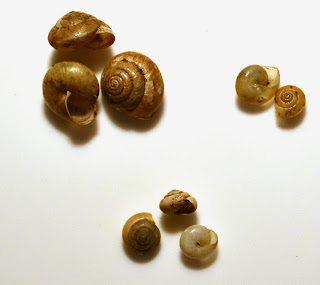Hygromia limbata Hygromia cinctella
Ashfordia granulata
Ivy
broomrape
|
Before starting the walk today we visited the
Teign Estuary at Coombe Cellars, where there were the usual common
brackish-water snails and many sea-slaters, but in the old elm hedges beside
an inland lane there are a number of rare alien land-snails. Here we recorded Hygromia limbata, H. cinctella, Phenacolimax major, Zenobiella
subrufescens & Ashfordia
granaulata.
The
coves on this stretch can only be reached along the shore, climbing over the
rocks at each headland, and this way eventually becomes impassable, so we
took the cliff-top path to Maidenscombe, hilly and steep, with few viewpoints
because the path is hedged. We noted
rock samphire, carline thistle, sheepsbit, wild madder and stinking
iris. Maidenscombe beach was small and
shingly, with a single hut selling fast food.
We went up aptly-named
We
drove into Torquay to stay at the imposing Osborne Hotel.
|
Day by day account of our walk around the coast of England, and the Welsh and Scottish borders, with notes on natural history.
Introduction
When we started walking the coast of England we had no intention that this would become a major lifetime project. Having to make a last-minute arrangement for our summer holiday in 1987, we said "Let's go to the nearest piece of coast and see how far we can walk along it." It turned out well and we started adding further stretches of coast, initially once every two years, but soon annually, or even twice a year.
We had always enjoyed the coast - there is something refreshingly "edgy" about having the sea always at our side, and one of us was into marine molluscs. We also enjoyed long-distance walking and had long been involved in general natural history recording. This project enabled us to combine all three interests.
You soon discover when embarking on a project like this that you need a few rules, which evolve from the first experiences. Our main rule was that we should walk as close to the coast as possible, which meant beach-walking whenever we could (unlike the official coast paths that largely remain above shore, recognising that at high tides the beach may be inaccessible). The route should also be capable of being a continuous walk, so that when we came to an unfordable river we walked inland along its banks to the first place at which we could cross, whether a bridge or a ferry.
We only carried light packs, so that at the end of each day's walk we had the problem of getting back to our car where we started. Initially we walked back, but soon realised we would be walking the coast twice this way! We used public transport whenever this was available - buses or trains, sometimes adjusting our start and finish points to make this easier. Failing this - and it was often not possible - we would phone for a taxi (an increasingly costly option over the years). Having our car with us gave us more freedom as to where we could stay at night - and after a day walking and only light food we were usually ready for being spoiled by a good meal and a comfortable bed! Even so, we stayed on the coast itself whenever there was a decent option.
Each walk was made for enjoyment, it was not a route-march to see how quickly we could get it finished. We therefore took it gently at times when passing through pleasant scenery or where there were many plants or creatures to record.
In terms of biological recording, we systematically noted every bird, butterfly, creature or sea-shell that we came across, sometimes spending time searching for the shells. We could not record every plant in the same way - there are too many common ones - so we were more selective, noting all coastal plants and any others that were not run-of-the-mill.
In our daily posts, edited from our original diaries, we include a star-rating from no star to **** according to our subjective estimate as to how special that day was from the point of view of natural history. This score (and our daily records) will, however, have been affected by the weather - it is difficult to appreciate the environment fully, for instance, in torrential rain, and there are many more butterflies and other insects to be seen in warm sunshine!
A summary of all our natural history records on the walk can be found using this link: https://drive.google.com/file/d/0B1LLGD55lKRHYXd1SGU1QndrcUU/edit?usp=sharing
Friday, 13 December 2013
South Devon 7/8/1994 Shaldon to Babbacombe****
Subscribe to:
Post Comments (Atom)



No comments:
Post a Comment